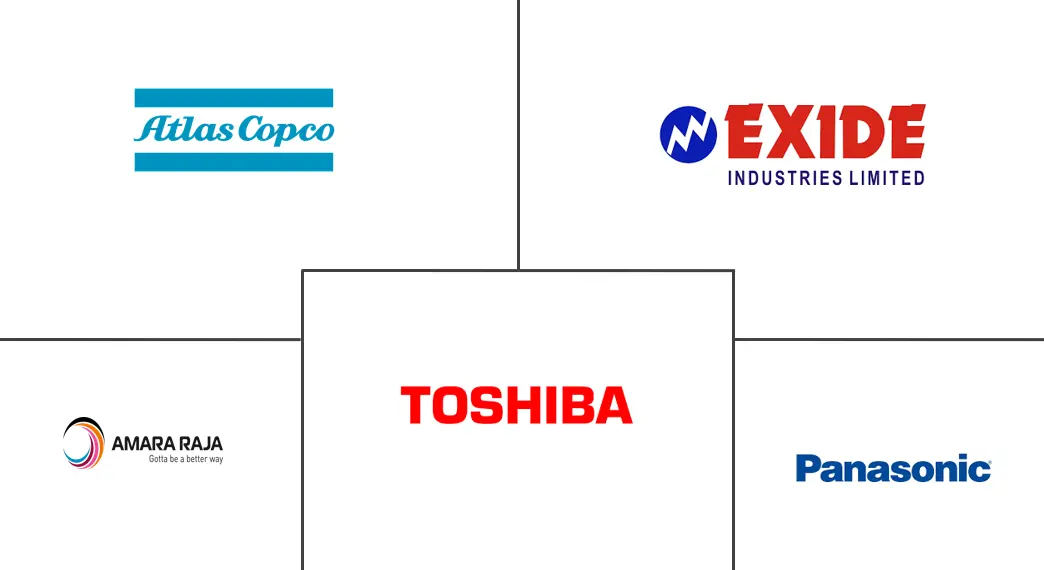India Stationary Battery Energy Storage System Market Size and Share
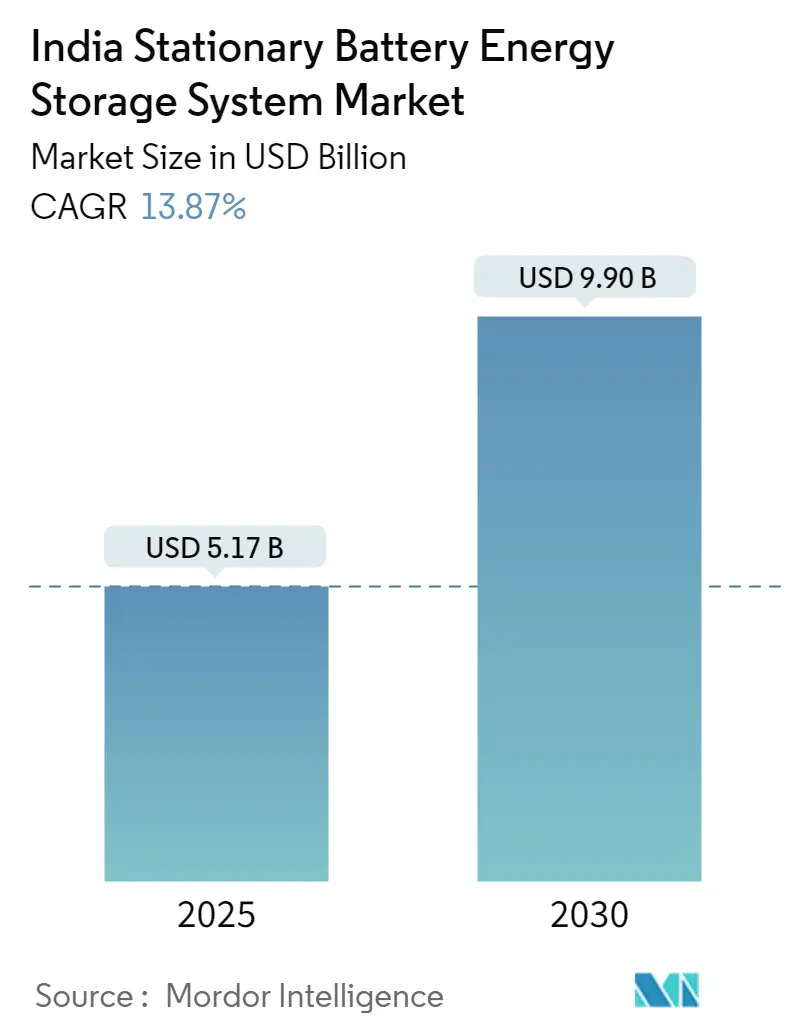
India Stationary Battery Energy Storage System Market Analysis by Mordor Intelligence
The India Stationary Battery Energy Storage System Market size is estimated at USD 5.17 billion in 2025, and is expected to reach USD 9.90 billion by 2030, at a CAGR of 13.87% during the forecast period (2025-2030).
- Over the medium period, the increasing adoption of solar energy and the declining cost of lithium-ion batteries are expected to drive the market.
- On the other hand, the presence of alternative energy storage systems is expected to hamper the market during the forecast period.
- Nevertheless, advancements in lithium battery technology are expected to create significant market opportunities in the future.
India Stationary Battery Energy Storage System Market Trends and Insights
Lithium-ion Battery Expected to Grow Significantly
- In India, lithium-ion batteries for stationary industries have gained prominence during the last decade compared to other countries. In comparison to different battery types, these batteries provide more advantages. Lithium-ion (Li-ion) batteries are nearly 100% efficient in charge and discharge, allowing the same ampere-hours in and out. These batteries offer various technical advantages over other technologies, such as lead-acid batteries. Rechargeable Li-ion batteries, on average, offer cycles more than 5,000 times, compared to lead-acid batteries that last around 400 to 500 times.
- Lithium-ion batteries can be recharged numerous times and are more stable. Furthermore, they tend to have a higher energy density, voltage capacity, and lower self-discharge rate than other rechargeable batteries. This improves power efficiency as a single cell has longer charge retention than different battery types.
- Further, the decreasing price of lithium-ion batteries has shifted the battery manufacturers' attention toward this battery type. In 2023, the price of lithium-ion battery packs decreased by 14% compared to the previous year to USD139/kWh. In addition to these advantages, research and development are being conducted to manufacture more effective and efficient lithium battery materials for stationary battery energy storage systems.
- For instance, in August 2024, Best Power Equipments (BPE), a prominent player in stationary power solutions, launched a 20,000-square-foot factory in Greater Noida, Uttar Pradesh, India. The fully operational facility boasts advanced automated systems tailored for large-scale manufacturing of lithium-ion batteries and stationary BESS. Such initiatives further boost the market’s growth.
- In the future, the domestic manufacturing of more efficient lithium-ion battery technology is expected to drive the segment further. For instance, many regional companies are investing in lithium-ion battery technology. In May 2024, DAEWOO unveiled its latest innovation: the Maintenance-Free Lithium Inverter for Indian markets. This lithium-ion battery technology redefines reliability and emphasizes convenience, ensuring seamless operation alongside eco-friendly advantages.
- Thus, owing to the decreasing prices and technological development, the segment is expected to grow significantly during the forecast period.
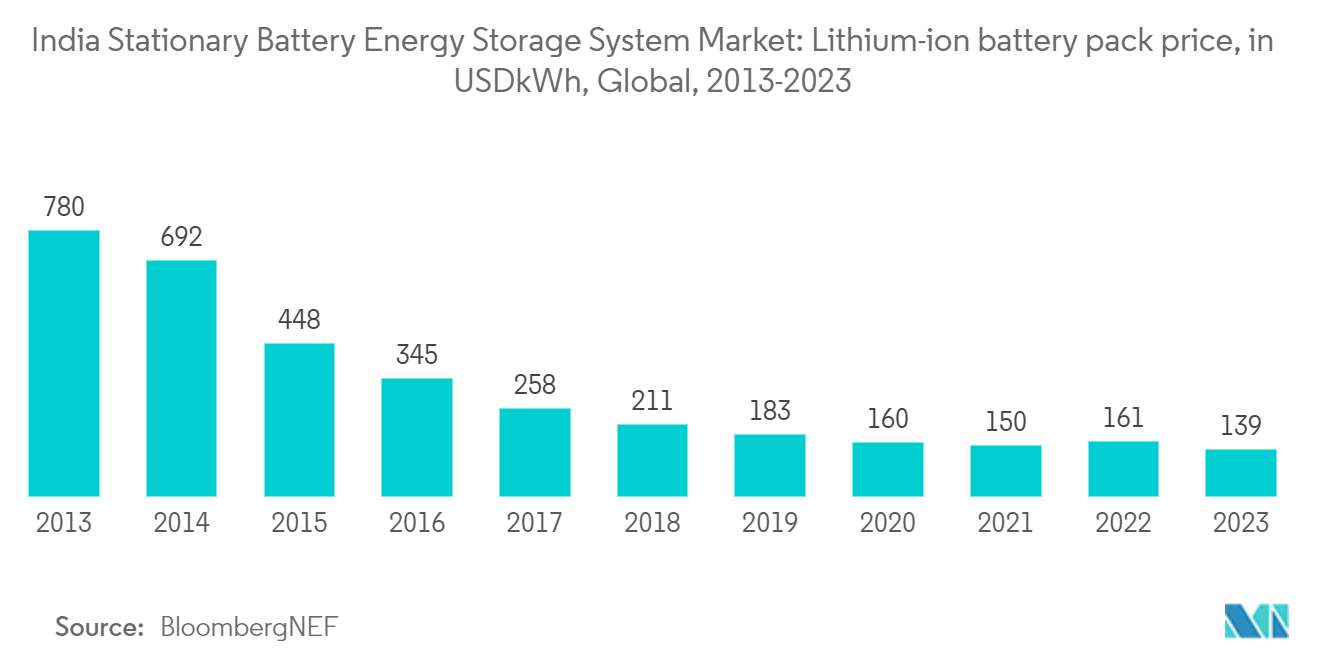
On-grid Connection Expected to Record Major Share
- An on-grid stationary battery energy storage system is designed to store and manage energy connected to the electrical grid. It can draw power from the grid and supply stored energy back to it. These systems are used to store excess energy (often from renewable sources like solar or wind) when production exceeds demand. They release energy back to the grid during peak demand periods or when renewable generation is low.
- India has witnessed consistent growth in its solar energy capacity. According to the Ministry of Power, solar power contributed the highest share in the renewable energy mix, accounting for 38.9% as of May 2023. This growth was driven by government initiatives, favorable policies, decreasing solar equipment costs, and a commitment to renewable energy sources.
- The Indian government has implemented various policies to promote energy storage. For instance, in September 2023, the Union Cabinet approved a viability gap funding (VGF) scheme to establish a robust storage system for managing excess wind and solar power. Under this scheme, 4,000 MWh of battery energy storage system (BESS) projects are set to be developed by FY2031. The scheme has an initial allocation of INR 94 billion, which includes INR 37.60 billion in budgetary support.
- These incentives encourage investments in on-grid BESS, making it more attractive for developers and consumers. For instance, in April 2023, India Grid Trust announced the commissioning of its first battery energy storage system (BESS) project, integrated with solar panels at the Dhule substation in Maharashtra. According to a company statement, this project is designed to fulfill the substation's auxiliary consumption needs.
- Further, several tenders have been issued in India for solar battery energy storage system (BESS) projects, reflecting the growing interest and investment in energy storage solutions to support the country’s renewable energy goals.
- Additionally, collaborations between government entities, private companies, and international organizations are facilitating the development of on-grid BESS projects. These partnerships enhance funding opportunities and technological expertise in the market.
- For instance, in March 2024, JSW Renew Energy Five, a fully owned subsidiary of JSW Neo Energy, entered a power purchase agreement (PPA) with Solar Energy Corporation of India Limited (SECI) for the initial phase of two 250 MW/500 MWh battery energy storage system (BESS) projects. Under this agreement, JSW Energy Limited, the parent company of JSW Renew Five, will receive payment for 60% of the project's total capacity (150 MW/300 MWh) over 12 years, with a fixed monthly capacity charge of INR 108,400 (approximately USD 1,310) per MW.
- Together, these factors create a favorable environment for the growth of the on-grid segment of the Indian stationary battery energy storage system market during the forecast period.
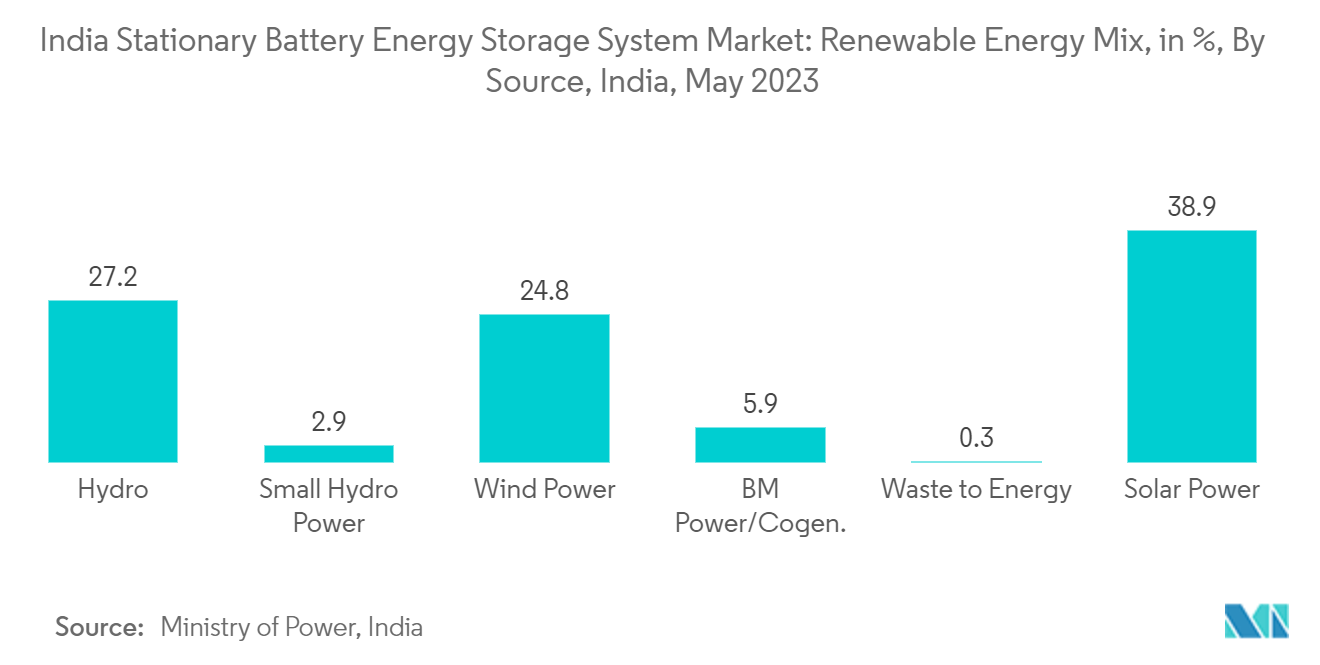
Competitive Landscape
The Indian stationary battery energy storage system market is semi-fragmented. Some of the major players in the market (in no particular order) include Toshiba Corporation, Amara Raja Energy & Mobility Limited, Exide Industries Ltd, Atlas Copco AB, and Panasonic Holdings Corporation.
India Stationary Battery Energy Storage System Industry Leaders
-
Toshiba Corporation
-
Amara Raja Energy & Mobility Limited
-
Exide Industries Ltd
-
Atlas Copco AB
-
Panasonic Holdings Corporation
- *Disclaimer: Major Players sorted in no particular order
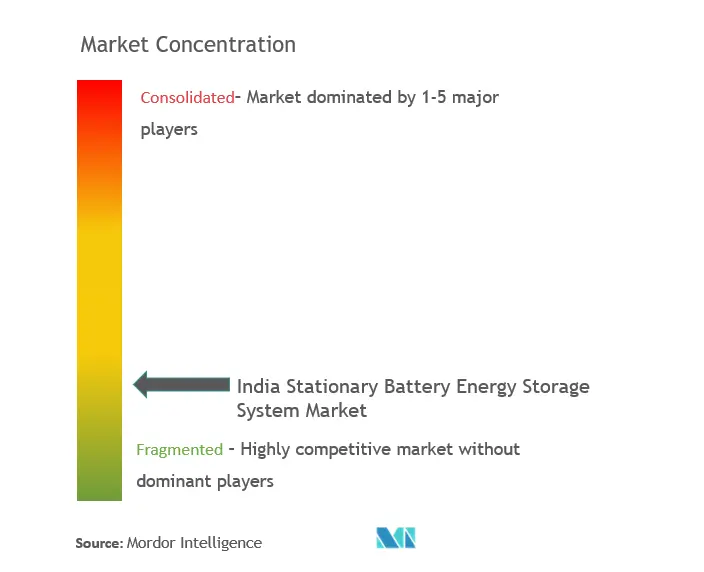
Recent Industry Developments
- June 2024: Bihar State Power Generation Company (BSPGCL) awarded an order to Larsen & Toubro (L&T) to construct a grid-connected 185 MW solar power project in the Lakhisarai district. This project is integrated with a 254 MWh stationary battery energy storage system. Approximately 80% of the generated power will be utilized, while the remaining 20% will charge the battery energy storage system.
- June 2024: JSW Energy commenced the construction of a 1,000 MWh battery energy storage system in Fatehgarh, Rajasthan, India. The project, awarded by the Solar Energy Corporation of India (SECI), will be executed in two phases, each featuring two units with a storage capacity of 500 MWh, allowing for two hours of storage per cycle. Tentatively, the project aims to be commissioned by 2025.
- May 2024: Statcon Energia launched a 3-kW single-phase grid-tie solar inverter designed specifically for residential and small office use. Further, the firm also introduced a 5 kW inverter. Key attributes of the inverter encompass a low current distortion factor, advanced MPPT for enhanced solar generation, support for a wide range of PV voltages, and an advanced phase-locked loop for a seamless grid-interactive mode.
India Stationary Battery Energy Storage System Market Report Scope
A stationary battery energy storage system captures energy and delivers it as electricity when required. Stationary battery energy storage systems are used in applications such as inverters, uninterrupted power supply (UPS), and solar energy storage. Stationary battery energy storage systems are also used in utility grids to supply electricity to consumers to serve larger loads.
The Indian stationary battery energy storage system market is segmented into battery technology, connection type, end user, and application. By battery technology, the market is segmented into lithium-ion batteries, lead-acid batteries, and other battery technologies. By connection type, the market is segmented into on-grid and off-grid. By end user, the market is segmented into residential, commercial and industrial, and utility. By application, the market is segmented into inverter, uninterruptible power supply (UPS), and solar energy storage applications. The report offers the market size in value terms (USD) for all the abovementioned segments.
| Lithium-ion Batteries |
| Lead-acid Batteries |
| Other Battery Technologies |
| On-grid |
| Off-grid |
| Residential |
| Commercial and Industrial |
| Utility |
| Inverter |
| Uninterruptible Power Supply (UPS) |
| Solar Energy Storage Applications |
| By Battery Technology | Lithium-ion Batteries |
| Lead-acid Batteries | |
| Other Battery Technologies | |
| By Connection Type | On-grid |
| Off-grid | |
| By End User | Residential |
| Commercial and Industrial | |
| Utility | |
| By Application | Inverter |
| Uninterruptible Power Supply (UPS) | |
| Solar Energy Storage Applications |
Key Questions Answered in the Report
How big is the India Stationary Battery Energy Storage System Market?
The India Stationary Battery Energy Storage System Market size is expected to reach USD 5.17 billion in 2025 and grow at a CAGR of 13.87% to reach USD 9.90 billion by 2030.
What is the current India Stationary Battery Energy Storage System Market size?
In 2025, the India Stationary Battery Energy Storage System Market size is expected to reach USD 5.17 billion.
Who are the key players in India Stationary Battery Energy Storage System Market?
Toshiba Corporation, Amara Raja Energy & Mobility Limited, Exide Industries Ltd, Atlas Copco AB and Panasonic Holdings Corporation are the major companies operating in the India Stationary Battery Energy Storage System Market.
What years does this India Stationary Battery Energy Storage System Market cover, and what was the market size in 2024?
In 2024, the India Stationary Battery Energy Storage System Market size was estimated at USD 4.45 billion. The report covers the India Stationary Battery Energy Storage System Market historical market size for years: 2019, 2020, 2021, 2022, 2023 and 2024. The report also forecasts the India Stationary Battery Energy Storage System Market size for years: 2025, 2026, 2027, 2028, 2029 and 2030.
Page last updated on:
India Stationary Battery Energy Storage System Market Report
Statistics for the 2025 India Stationary Battery Energy Storage System market share, size and revenue growth rate, created by Mordor Intelligence™ Industry Reports. India Stationary Battery Energy Storage System analysis includes a market forecast outlook for 2025 to 2030 and historical overview. Get a sample of this industry analysis as a free report PDF download.
